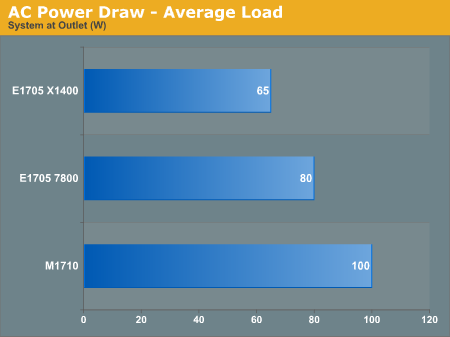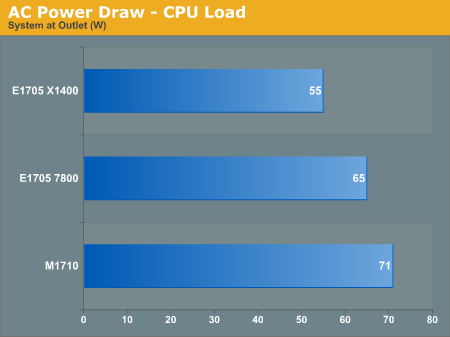Dell DTR Laptop Shootout - M1710 vs. E1705
by Jarred Walton on May 30, 2006 1:30 PM EST- Posted in
- Laptops
Power Consumption
For power testing, we removed the battery from the laptop and measured system power draw at the wall outlet using a Kill-A-Watt device. All three laptops were configured to run at maximum performance when plugged into AC power. We tested under stress conditions as with the noise and temperature benchmarks, but we also added a couple more results. First, we have peak power draw, which is often quite a bit higher than the typical average maximum power. We then got a rough estimate of the average power draw under full load, as well as a maximum power draw when only the CPU is placed under full load using two instances of Folding@Home. Finally, we have idle power draw, where the system has been sitting with no applications running for 10 minutes or more. The screensaver is disabled, as is the hard drive sleep mode.



Why would anyone want to get the X1400 in such a laptop? Obviously, because it uses far less power than even the GeForce Go 7800. While 10 to 12 W might not seem like a big deal, that represents 25 to 30% more power draw. Considering that the battery is rated as 80 WHr, a load of 20 Watts will last roughly 4 hours while 30 Watts will only last 2 1/2 hours. That's the theory anyway, so we'll turn to our battery tests to find out exactly how long the systems can run under typical usage.
We also tested power draw with the LCD at maximum brightness and minimum brightness. The total difference was only 6 W, indicating that the LCD manages to be very power efficient. There are eight brightness levels on the LCD, and power draw scales pretty much linearly as you go from level 1 to level 8. The default brightness when running on battery power is 3, although if you use the system in direct sunlight you will definitely need to crank that up. Going with the maximum setting will reduce your battery life somewhat, but you shouldn't lose more than 30 minutes of battery life at worst by setting it at maximum intensity.










34 Comments
View All Comments
NullSubroutine - Tuesday, May 30, 2006 - link
In the article the author mentioned the painfulness of disassembling the laptop system, however I disagree. While not being two thumb screws like on some desktops, after taking apart the laptop (which doesnt void your warrenty, as tell had me disassemble so to take the CD/DVD drive in and out to fix a glitch) after a few times, it becomes a breeze. I can take it apart in less than a minute.I would have liked to have seen the comparison of the 7900 GS vs the 7800. As a early i9400 buyer, I was plagued with the 7800 (didnt realize it wasnt the 7800 Go GTX until after it was purchased), there is some good info on i think its called notebookforums or something on how to overclock your gpu with some volt mods. I could get 485/965 on 1.3 volt mod, but it gets hot, and accept a 450/960 on 1.2v (default is 1.1) the 130watt psu helps (I highly recommend) and you should prop up your laptop. I use two 'crystal light cup packs' under each backside pad; I actually perfer it propped as it is easier to type with the backside elevated a bit.
Unfortunetely, dell isnt shipping the 7900 Go GTX, otherwise you could drop that video card right into an older shipping model of the i9400. You can always slightly mod your case and put the 7800 Go GTX in there...but I'm personally gonna wait (and save money) to get the 7900 Go GTX later, or get the 8800 Go GTX sometime later this year if it is released (dell will offer it for the m1710 and it will fit right into the i9400). But this is only if I really decide to droop myself low enough to switch to Vista....shutters....I really hate MS for making DX10 Vista only.
Also, Dell said the Memron will work perfectly (needing at most a bios update) with either laptop.
ElFenix - Tuesday, May 30, 2006 - link
and what pipe configuration does it have?thanks!
JarredWalton - Wednesday, May 31, 2006 - link
20 pixel, 7 vertex (I think), 375/1000 clocks are typical. I'm not positive what the Dell model has on clocks, as there is some variation, but it should still be quite a bit faster than the GF Go 7800. I figure the GF Go 7900 GTX adds another 20-30% in performance, however, as it has even higher clocks (500/1200 with 24/8 pipelines).anandlurker - Tuesday, May 30, 2006 - link
I'm glad that Anandtech include Source DoD for benchmarking, i love this game but when i bought my $300 7800gt just to play this game, the results were mediocre and rather disappointing for this kinda of price. I hope future benchmark from Anandtech include this game, it's a nice simple multiplayer game that seems to render 7800 series useless(pricewise).JarredWalton - Wednesday, May 31, 2006 - link
The fastest scores I've seen on DODS top out at around 67 FPS with audio enabled. (Overclocked FX-62 running 3.08 GHz.) The game is very CPU limited, at least with any reasonable GPU. That said, I find 40 FPS to be very playable on this particular title, though lots of people want higher frame rates.turkster - Tuesday, May 30, 2006 - link
you dont even need the modified INF drivers, the installed Nvidia drivers that came with my M1710 will allow me fix aspect ratio and set scaling options without any problem.For those interested my M1710 (T2500 2Ghz, 2GB RAM) with 7900GS graphics card scored 3805 in 3dmark06 straight out of the box with no tweaks or new drivers etc. This seems a quite respectable score and puts it considerably ahead of the 7800go. I havent done any further benchmarks yet but my experience so far shows that it is quite capable of playing FEAR at 1920x1200 4xAA perfectly smoothly, similarly FarCry and HL2. As such it would seems like quite a good option for those who cant quite stomach the rather steep price of 7900GTX.
JarredWalton - Tuesday, May 30, 2006 - link
So there is an option to do 1:1 scaling - I've removed the paragraph on this. I would have never thought to look in the drivers for this, and it certainly could be placed in a more prominent position. I guess I'm just used to older laptops that did this via BIOS/keyboard shortcuts. (I'm getting old.... LOL)mrSHEiK124 - Tuesday, May 30, 2006 - link
You actually can have the laptop scale resolution while preserving aspect ratio, you just need to install nVIDIA's desktop drivers w/the modified INF that allows them to run on mobile parts and then you can use the scaling settings built into the drivers.ahmshaegar - Tuesday, May 30, 2006 - link
Now I don't know about the Nvidia-based laptops, but I have the Dell Inspiron E1505 (with ATI x1400 Mobility) and to have the aspect resolution preserved when changing resolutions, there's an option in the control panels (both CCC and the old ATI control panels have the option to preserve aspect ratio when changing resolutions.) I'm guessing that it would be the same for Nvidia.Thor86 - Tuesday, May 30, 2006 - link
So, instead of reviewing DTRs, which it seems no-one really cares about, how about a review of ultra-portables?